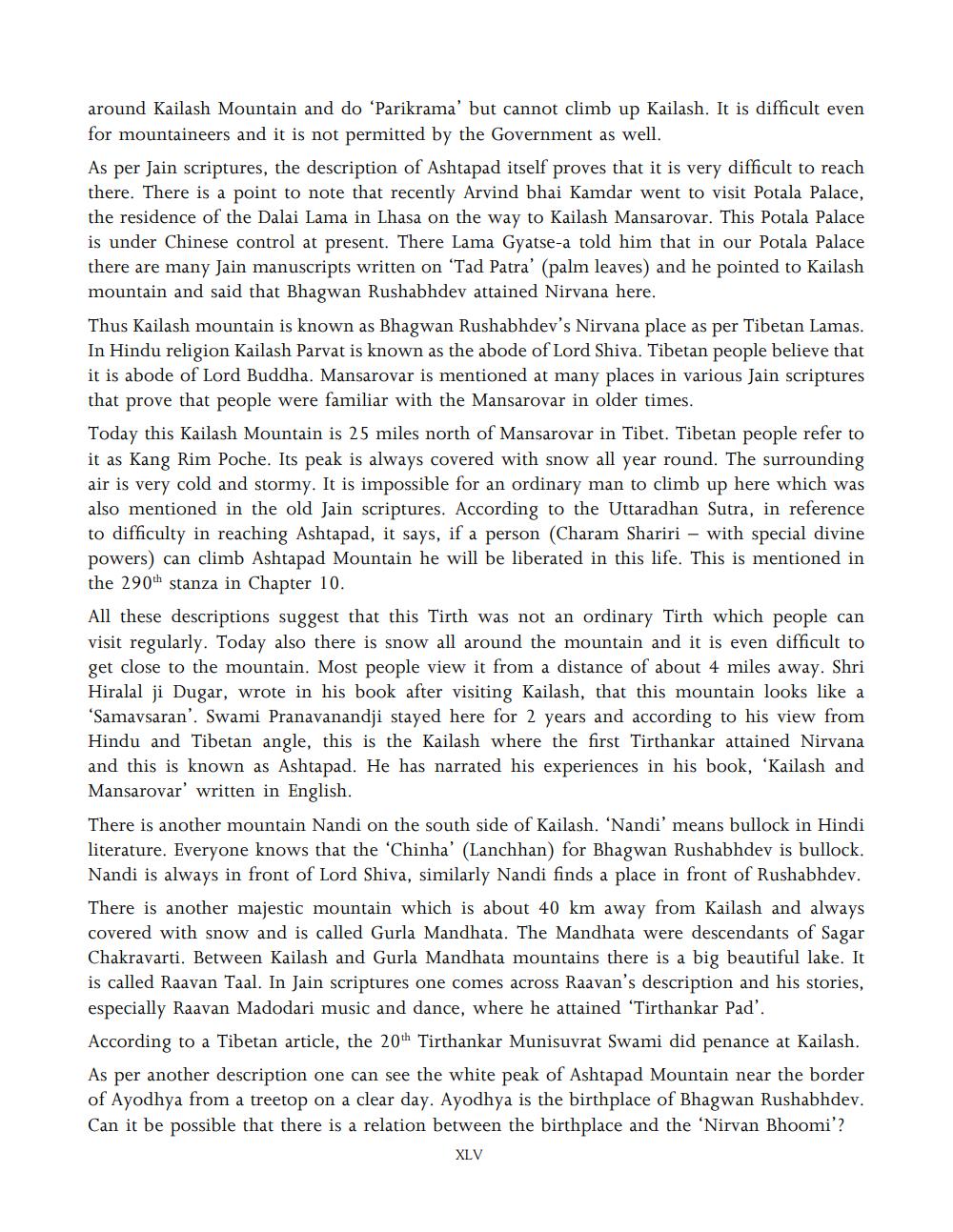________________
around Kailash Mountain and do 'Parikrama' but cannot climb up Kailash. It is difficult even for mountaineers and it is not permitted by the Government as well.
As per Jain scriptures, the description of Ashtapad itself proves that it is very difficult to reach there. There is a point to note that recently Arvind bhai Kamdar went to visit Potala Palace, the residence of the Dalai Lama in Lhasa on the way to Kailash Mansarovar. This Potala Palace is under Chinese control at present. There Lama Gyatse-a told him that in our Potala Palace there are many Jain manuscripts written on 'Tad Patra' (palm leaves) and he pointed to Kailash mountain and said that Bhagwan Rushabhdev attained Nirvana here.
Thus Kailash mountain is known as Bhagwan Rushabhdev's Nirvana place as per Tibetan Lamas. In Hindu religion Kailash Parvat is known as the abode of Lord Shiva. Tibetan people believe that it is abode of Lord Buddha. Mansarovar is mentioned at many places in various Jain scriptures that prove that people were familiar with the Mansarovar in older times.
Today this Kailash Mountain is 25 miles north of Mansarovar in Tibet. Tibetan people refer to it as Kang Rim Poche. Its peak is always covered with snow all year round. The surrounding air is very cold and stormy. It is impossible for an ordinary man to climb up here which was also mentioned in the old Jain scriptures. According to the Uttaradhan Sutra, in reference to difficulty in reaching Ashtapad, it says, if a person (Charam Shariri - with special divine powers) can climb Ashtapad Mountain he will be liberated in this life. This is mentioned in the 290th stanza in Chapter 10.
All these descriptions suggest that this Tirth was not an ordinary Tirth which people can visit regularly. Today also there is snow all around the mountain and it is even difficult to get close to the mountain. Most people view it from a distance of about 4 miles away. Shri Hiralal ji Dugar, wrote in his book after visiting Kailash, that this mountain looks like a 'Samavsaran'. Swami Pranavanandji stayed here for 2 years and according to his view from Hindu and Tibetan angle, this is the Kailash where the first Tirthankar attained Nirvana and this is known as Ashtapad. He has narrated his experiences in his book, 'Kailash and Mansarovar' written in English.
There is another mountain Nandi on the south side of Kailash. 'Nandi' means bullock in Hindi literature. Everyone knows that the 'Chinha' (Lanchhan) for Bhagwan Rushabhdev is bullock. Nandi is always in front of Lord Shiva, similarly Nandi finds a place in front of Rushabhdev. There is another majestic mountain which is about 40 km away from Kailash and always covered with snow and is called Gurla Mandhata. The Mandhata were descendants of Sagar Chakravarti. Between Kailash and Gurla Mandhata mountains there is a big beautiful lake. It is called Raavan Taal. In Jain scriptures one comes across Raavan's description and his stories, especially Raavan Madodari music and dance, where he attained 'Tirthankar Pad'.
According to a Tibetan article, the 20th Tirthankar Munisuvrat Swami did penance at Kailash. As per another description one can see the white peak of Ashtapad Mountain near the border of Ayodhya from a treetop on a clear day. Ayodhya is the birthplace of Bhagwan Rushabhdev. Can it be possible that there is a relation between the birthplace and the 'Nirvan Bhoomi'?
XLV




